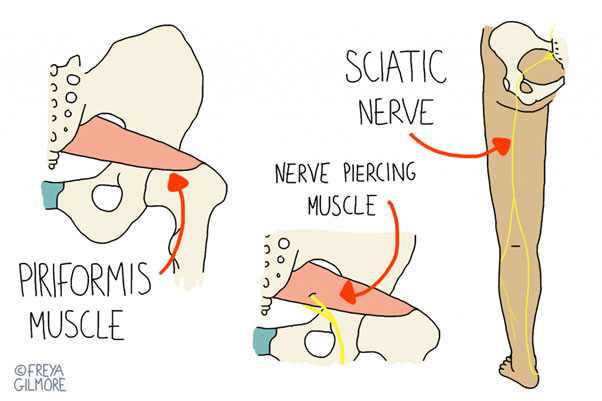Piriformis syndrome is when a deep muscle in the buttock (piriformis) causes irritation to the sciatic nerve.

Anatomy of the Area
The piriformis muscle is a small, deep muscle in the glutes that rotates and extends the hip (brings it backwards). The sciatic nerve runs nearby, or in some cases, through the muscle. As a result, tension in the piriformis can result in leg pain, numbness, or weakness. Some people seem particularly prone to developing piriformis syndrome, and may find that it tends to come back regularly or with seemingly little aggravation.
A change in exercise or other demands can lead to piriformis syndrome. Taking up cycling, or increasing the intensity or duration is one example of this. Pregnancy is another time when it may be more prevalent: postural changes ask more of the gluteal muscles. This often causes the hips to be held in extension, with the glutes working harder to allow this. Later on in pregnancy, the development of a waddling gait can add external rotation to the hip. Therefore, the piriformis is under even more demand, so sciatic symptoms may follow.
Keeping strong and making sure any changes to your exercise routine are gently graded can help to prevent flare ups. But for times when it can’t be avoided, our osteopaths are at hand to help you.
Piriformis Syndrome and Sciatica
Sciatica is technically just a symptom. Piriformis syndrome symptoms are caused by irritation of the sciatic nerve, so yes- piriformis syndrome is just a form of sciatica. Fortunately, it’s often a more straight-forward case than other causes of sciatica. If the primary cause is tightness in the gluteal muscles, releasing these should be the solution. The shorter the history of the pain, the better, as the nerve is less likely to be sensitised and should calm down more readily.
It is your osteopath’s job to identify a likely cause for your sciatica symptoms. We use a combination of your case history and our own examination to work this out. Signs of piriformis syndrome might include:
- aggravation from hip extension or external rotation
- prolonged sitting or standing
- squats and climbing stairs
You are less likely to feel your symptoms worsening when:
- coughing, sneezing, or straining
- slouching or twisting
- compressing the spine
as these are symptoms more commonly associated with disc bulges. You can read more about sciatica in our dedicated post here.
Sciatica can also be confused with the symptoms of referred pain. Trigger points in the lower back and buttocks, or irritation of a lower back joint can cause pain in the same area as sciatica. However, there are differences in the symptoms caused by this- pins and needles and weakness are much less likely, and the aggravating and relieving factors will likely be quite different. Your osteopath will use your history and examination to work out whether the nerve is involved at all.
Management of Piriformis Syndrome
Osteopaths are qualified to treat sciatica. Our holistic approach rings true here, as it does with other treatment plans. Relaxing off the gluteal muscles is likely to be the main component of management. Often this takes a combination of stretches and massages in clinic alongside exercises for you to continue at home. Looking deeper into the problem, we also want to know why the muscles were tight in the first place. If there is a weakness somewhere that has lead to an overstrain of the gluteal muscles, we can address this too. Sometimes this comes hand in hand with a stiff or lax joint, and once this is identified, we can mobilise or support it as appropriate.
In any case, the management strategy we develop for you will take into account all aspects of your presentation, and be fully tailored to you.
Piriformis Syndrome Management in Pregnancy
During pregnancy, the best approach may be a combination of relaxing the tight muscles and strengthening. Ideally, your posture would remain relatively unchanged in comparison to pre-pregnancy, but this does require a lot of strength. The posture commonly adopted in pregnancy is an energy-efficient way to stay upright when the centre of gravity moves forwards with the developing bump. But evidently, it is not without its draw-backs. If the muscles are strong enough to maintain the original posture, the hip extension and rotation will not be the default position.
To make this work, the anterior muscle chain needs to be strong. This includes the core and hip flexors. Even as the abdominal muscles separate in the second or third trimester, you can still strengthen and engage the muscles effectively, although some exercises will no longer be appropriate. Avoid exercises such as sit ups that cause your tummy to “cone”- your osteopath can suggest exercises that may be more suitable for you.
Click here to make an appointment in Leeds for your Piriformis Syndrome
References
- Ingraham, P., 2021. A Guide to Sciatica Treatment for Patients. [online] PainScience. Available at: <https://www.painscience.com/articles/sciatica.php> [Accessed 15 August 2022].
- Physiopedia. 2022. Piriformis Syndrome. [online] Available at: <https://www.physio-pedia.com/Piriformis_Syndrome> [Accessed 15 August 2022].
- nhs.uk. 2022. Your post-pregnancy body. [online] Available at: <https://www.nhs.uk/conditions/baby/support-and-services/your-post-pregnancy-body/> [Accessed 15 August 2022].



0 Comments